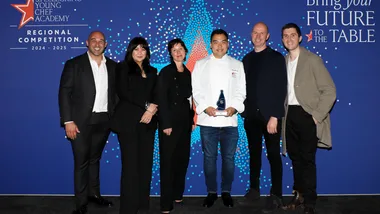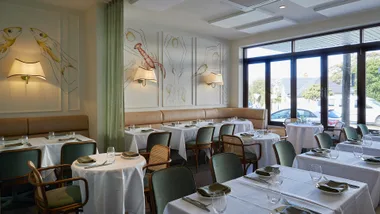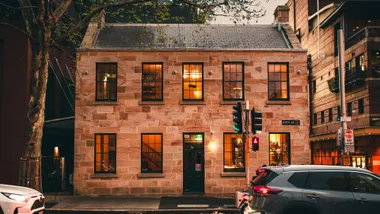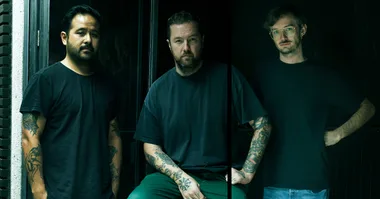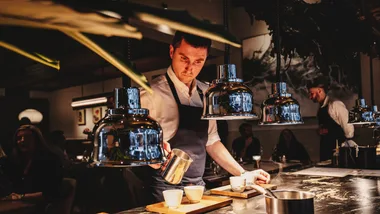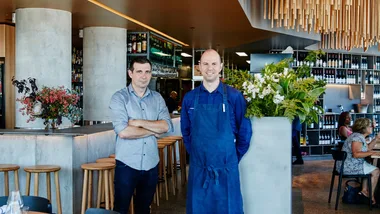Australia has been amazing. We’re all feeling a bit nostalgic already because it’s ending. It’s almost symbolic that the weather’s turning – the summer is ending, we’re leaving and we have to pop a hole in our bubble soon and go back and start again. It’s been a life-changing experience, for sure. I can only tell you that there’s Before Australia and After Australia. That’s for me personally and also for our team. Being in Sydney has brought us much closer together, and I thought we were already really, really close. There’s something more now.
One of the most amazing things has been cooking for Aussies. It’s been so much fun. I will miss so much standing at the pass and an Australian walks by and puts two thumbs up in the air and says, ‘Thank you – it’s amazing.’ That just doesn’t happen in Denmark. I cannot say that I’ve ever been to a place where I’ve felt this welcome. Even back home.
I understand that we’re here in a bubble, of course. We don’t have to set up shop permanently, so we’ve had the means to buy the best of the best of the best because we know that people here will accept the menu cost, even though a lot of our menu cost goes to housing – we have a $700,000 bill for our accommodation – we still spend a huge amount on ingredients. And that’s the bubble. If we were to stay here, to set up shop for 10 years, you can’t in the current climate in Sydney charge even $350 for a menu [Noma Australia charged $485 for its dégustation]. You might be full for a year, and then what?
All in all, as we come to the end I have only an incredible positive feeling. I’m not even tired. When we took the restaurant to Japan I was exhausted. Exhausted. Now I feel energised. I even cut my vacation time short because I want to start work again straight away. I was supposed to take two weeks off, now I’m taking five days. In a sense I’m also happy to leave, not because I’m not happy being here – I could easily stay another six months – but because this experienced has fuelled a desire in me to go and push harder when I get back to Denmark. And that’s something really valuable, an amazing feeling.
Read Pat Nourse’s review of Noma Australia here.
Redzepi on Australian ingredients
For diners, between Noma in Tokyo, Copenhagen and here, I think Sydney got the best experience. There’s something that clicked in Sydney for us. In terms of our journeys, in terms of how we understood ‘us’ as a team. How we understood Australia, the landscape and the people, and being able to shape that into a menu showcasing ingredients and high-quality cooking but also telling a story that people connected to and felt. We did that. And we’ve done it better than we did in Japan in my own personal feeling. We’ve been able to source top-of-the-line ingredients that are hard to beat anywhere in the world. It doesn’t matter if you get the best crab in Denmark or the world; will it be as good as Western Australian snow crab? Probably not.
We created a lot dishes that we didn’t use. We serve 14, and we ended up with about 17 that were finished to a level that we were all happy with. But we trialled 500 others, easily. And some of them were very, very good but they didn’t click with the rest of the menu. And then there were times when we had something great but we just couldn’t get enough of it, or we could only get it for two days. The Alexander palms. The yams we tasted in Western Australia that had the sweetness of a pear but the crunchiness of a turnip, but look like a potato. I was thinking a slice of that, a slice of that, a slice of pear and then maybe pepper leaves, and you bite into it and feel the textures and the juiciness.
Of all the dishes we did, I think I’m happiest with the berries with smoked oil, the shellfish platter and the abalone. With these things as a cook I’m getting to experience something new. New flavours. Ingredients I didn’t know. That’s been the most exciting thing. For the sheer moreish quality, I can’t go past the snow crab with fermented kangaroo meat. And the avocado – again, just that ‘arrgh, give me more of this’ quality. I could eat a bowl of the urchin, too. But we played around with so many other things. The abalone, for instance, is two dishes brought together. The garnishes for the abalone, the native seeds and leaves and seaweeds, were supposed to be the beginning of the meal, all set up in a landscapey kind of way as an introduction. But then we had this amazing schnitzel.
We’re really proud of the schnitzel, too, because the cooking technique is very different to the way you’d usually cook abalone. The textbooks say clean it, pound it, and then either slice it or cook it. But we cook it – we confit it overnight – and afterwards we tenderise it, which makes a huge difference to its tenderness. Cooking it slowly gives it a lot of flavour, too. It can be quite bland when you do it quickly. The flabby gelatinous fringe can be a bit tough, too, but when you cook it slowly it becomes like soft gelatine.
Redzepi on taking Australia home
I’m taking home a few souvenirs. I bought a whole case of those kangaroo-paw bottle-openers, so I’ll be passing a few of those around. But we also have two dozen kinds of seed that we’re taking back to try and grow at home. We’re going to see if we can grow wattle, for instance. Saltbush. Saltbush to me is just, wow – it could be as popular as parsley all over the world. We have an Aussie princess in Denmark; why can’t we have an Aussie ingredient base?
We’re also going to try and grow a finger lime tree. To me, that’s one of the most iconic ingredients. It’s a world-class ingredient that any cook can understand. If I really had a restaurant here, it’d be the one condiment that would always be on the table in front of me. That’s the taste of Australia to me.
Sometimes I’ve felt like I was in a movie while I’ve been here, walking around in my boots in these landscapes. I have a picture of me next to this three-and-a-half-metre-tall ant hill, and there’s 20 of them behind me. It’s just so extraordinary, and I’ve had hundreds of those experiences now. Diving in Tasmania. Unbelievable experience. The wild geese laying their eggs by their thousands on Flinders Island. I want to see more of Australia.
One thing we’ve all agreed is that we’re going to go home and do exactly what we did in Australia, but in Scandinavia. We’re going to spend the next four or five months researching again, planning the journeys. I’ve had many two-day trips, but not a full journey with a fresh, targeted plan. Let’s go out and meet people again and talk and recalibrate. I’m very excited for that. It’s even giving me chills.
If we’ve left anything here in Australia, meanwhile, it might be just a different view. A different idea of what Australian ingredients can be. Maybe a little bit of inspiration to some. The spirit of actually doing things and exploring your neighbourhood (and it’s a big neighbourhood) and falling in love with it and digging deep. A lot of chefs have said to me that they could never do that, that we had help to travel around. I always tell people: have you asked? Have you made a plan and presented a plan to somebody? And then actually asked if you could make a plan for you and your five chefs or you and your five chef friends from other restaurants to do something? I think my general feeling is that if you make a good plan, and it’s sound and reasonable and there’s a point to it, you will get all the help you can. Just do it. Free-fall into it. That’s what we always do.
A little bit of curiosity can yield great change.
Noma Australia’s 10-week pop-up at Barangaroo came to a close on April 2, 2016.

Abalone schnitzel
